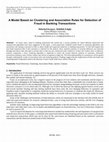Papers by Abdollah Eshghi

Proceedings of the 3rd World Congress on Electrical Engineering and Computer Systems and Science, Aug 1, 2018
In recent years, fraud in banking transactions has turned into a serious problem for which differ... more In recent years, fraud in banking transactions has turned into a serious problem for which different supervised and unsupervised algorithms have been suggested. In this paper, a semi-supervised combined model based on clustering algorithms and association rule mining is devised in order to detect frauds and suspicious behaviors in banking transactions. To this end original and non-fraud transaction data of the customers is collected for the analysis. Next, repetitive patterns of customer behaviors are extracted through association rules and used as normal rules so that any new transaction must conform to at least one of these rules. In behavior analysis component, a fuzzy clustering algorithm is employed to extract the normal behavior patterns of customers. Abnormal transactions belong to none of these clusters and will be recognized as high risk. The final understanding of a transaction will be gained through combining the results of association rules and clustering patterns. Findings suggest that the employment of both rule-based and clustering-based components leads to the detection of more frauds while fewer alarms will go off.
DOAJ (DOAJ: Directory of Open Access Journals), Mar 1, 2018
Expert Systems With Applications, May 1, 2019
This is a PDF file of an unedited manuscript that has been accepted for publication. As a service... more This is a PDF file of an unedited manuscript that has been accepted for publication. As a service to our customers we are providing this early version of the manuscript. The manuscript will undergo copyediting, typesetting, and review of the resulting proof before it is published in its final form. Please note that during the production process errors may be discovered which could affect the content, and all legal disclaimers that apply to the journal pertain. Highlights Using several evidence for determining the state of a transaction (fraud or not fraud) Declaring the problem of uncertainty in fraud detection Using Multi Criteria Decision Making method and intuitionistic fuzzy method for the fusion of fraud evidence Getting better results compared with Dempster-Shafer fusion method

As electronic transactions are growing, fraud cases are also growing drastically. Detection of fr... more As electronic transactions are growing, fraud cases are also growing drastically. Detection of frauds is a complicated task and limiting fraud detection systems to certain kinds of detection methods like supervised or unsupervised methods does not seem efficient. In this paper, a combination framework for fraud detection systems, consisting of both supervised and semi-supervised methods in three main components namely rule-based component, trend-analysis-based component and, a scenario-based component is proposed. The rule-based component is the supervised part of the framework and decision tree which is a cost-insensitive classification algorithm is used for this component. In the trend-analysis-based component, which is the semi-supervised part of our proposed framework, the normal behavior of users are modeled and the extent of dissimilarities of newly-arrived transactions are calculated. Finally, in the scenario-based component which is another semi-supervised part of the proposed framework, the extent of similarities of the sequence of transactions to known fraud scenarios are calculated. The final result is gained through combining the results of all these three components using in a parallel mode. By combining the outputs of all these components together using the SUM function, the detection rate has increased remarkably (about 7%).
2023 9th International Conference on Web Research (ICWR)

2019 15th Iran International Industrial Engineering Conference (IIIEC)
As electronic transactions are growing, fraud cases are also growing drastically. Detection of fr... more As electronic transactions are growing, fraud cases are also growing drastically. Detection of frauds is a complicated task and limiting fraud detection systems to certain kinds of detection methods like supervised or unsupervised methods does not seem efficient. In this paper, a combination framework for fraud detection systems, consisting of both supervised and semi-supervised methods in three main components namely rule-based component, trend-analysis-based component and, a scenario-based component is proposed. The rule-based component is the supervised part of the framework and decision tree which is a cost-insensitive classification algorithm is used for this component. In the trend-analysis-based component, which is the semi-supervised part of our proposed framework, the normal behavior of users are modeled and the extent of dissimilarities of newly-arrived transactions are calculated. Finally, in the scenario-based component which is another semi-supervised part of the proposed framework, the extent of similarities of the sequence of transactions to known fraud scenarios are calculated. The final result is gained through combining the results of all these three components using in a parallel mode. By combining the outputs of all these components together using the SUM function, the detection rate has increased remarkably (about 7%).

World Congress on Electrical Engineering and Computer Systems and Science, 2018
In recent years, fraud in banking transactions has turned into a serious problem for which differ... more In recent years, fraud in banking transactions has turned into a serious problem for which different supervised and unsupervised algorithms have been suggested. In this paper, a semi-supervised combined model based on clustering algorithms and association rule mining is devised in order to detect frauds and suspicious behaviors in banking transactions. To this end original and non-fraud transaction data of the customers is collected for the analysis. Next, repetitive patterns of customer behaviors are extracted through association rules and used as normal rules so that any new transaction must conform to at least one of these rules. In behavior analysis component, a fuzzy clustering algorithm is employed to extract the normal behavior patterns of customers. Abnormal transactions belong to none of these clusters and will be recognized as high risk. The final understanding of a transaction will be gained through combining the results of association rules and clustering patterns. Findings suggest that the employment of both rule-based and clustering-based components leads to the detection of more frauds while fewer alarms will go off.
Communications in Computer and Information Science, 2019
Big data tools and techniques introduce new approaches based on distributed computing methods. Wh... more Big data tools and techniques introduce new approaches based on distributed computing methods. When dealing with large data, one of these state-of-art approaches for analysing and predicting in the shortest possible time is the use of deep learning networks that provide real-time, accurate, and comprehensive analysis. This method has provided a new perspective to artificial intelligence with respect to increasing volume of data and complexity of real-world issues. The models used to predict customer behavior have mainly worked with limited features and dimensions. One of the applications of this method is to prevent customer churn, when predicting future behavior of customer transaction on point of sale (POS) devices.
Expert Systems with Applications, 2018
This is a PDF file of an unedited manuscript that has been accepted for publication. As a service... more This is a PDF file of an unedited manuscript that has been accepted for publication. As a service to our customers we are providing this early version of the manuscript. The manuscript will undergo copyediting, typesetting, and review of the resulting proof before it is published in its final form. Please note that during the production process errors may be discovered which could affect the content, and all legal disclaimers that apply to the journal pertain. Highlights Using several evidence for determining the state of a transaction (fraud or not fraud) Declaring the problem of uncertainty in fraud detection Using Multi Criteria Decision Making method and intuitionistic fuzzy method for the fusion of fraud evidence Getting better results compared with Dempster-Shafer fusion method
International Journal of Industrial Engineering & Production Research, 2018











Uploads
Papers by Abdollah Eshghi